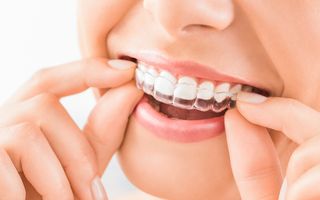Teeth straightening: Aligners vs. braces - choosing the right one

When it comes to achieving a beautifully straight and well-aligned smile, braces and aligners are two popular options for correcting crooked teeth. But what’s the difference between the two? And which option is best for your teeth straightening needs?
Whether your orthodontist has recommended a teeth straightening treatment for your child, or you’re an adult wanting to straighten your teeth, you’ll probably have questions about whether braces or aligners are more suitable.
In this article, we’ll explore the types of braces and why retainers are necessary after any orthodontic treatment.
By understanding the advantages of straightening your teeth with braces vs. aligners and the purpose of retainers, you can start your journey to a straighter smile!
Understanding teeth straightening
What is teeth straightening?
Teeth straightening, also known as orthodontic treatment, is a process that involves correcting misaligned, crooked, or protruding teeth to achieve a straighter smile.
This treatment can significantly improve the overall appearance of your teeth, boost your self-confidence, and enhance your oral health. Various methods can be used to straighten teeth, including traditional metal braces, ceramic braces, lingual braces, and clear aligners.
Each method has its unique advantages, making it possible to find a solution that fits your specific needs and lifestyle.
How teeth straightening works
Teeth straightening works by applying gentle, continuous force to the teeth over time, gradually moving them into their desired positions. This process can take several months to several years, depending on the severity of the orthodontic issue and the type of treatment used.
Regular appointments with an orthodontist or dentist are necessary to monitor progress, make adjustments to braces or aligner sets, and ensure that the treatment is on track. By following the prescribed treatment plan, you can achieve a beautifully aligned smile and improved oral health.

Using braces or aligners to straighten your teeth
What do braces do to the teeth?
Braces work by applying continuous, gentle pressure on the teeth, in order to gradually move them into their correct positions over time. Regular adjustments are necessary to maintain the pressure and ensure the teeth’s proper alignment.
Braces can correct various dental issues, including misaligned teeth, crowded teeth, gaps, and bite problems, resulting in a straighter, more well-aligned smile. By correcting these issues, braces can also help reduce the risk of tooth decay by making it easier to maintain proper oral hygiene.
What type of braces can be used to straighten teeth?
- Metal braces: Traditional metal braces are the most common teeth straightening method, particularly if your teeth need to be repositioned significantly. Metal braces consist of metal brackets that are attached to the teeth and connected with a thin metal wire, which is adjusted at regular intervals.
- Ceramic braces: Ceramic braces use brackets and wires that are clear or tooth-coloured, giving them a more natural-looking appearance that is less visible compared with metal braces.
- Lingual braces: Lingual braces are placed on the inside surface of the teeth, meaning they're not visible from the outside. These clear braces are popular with people seeking a more subtle teeth straightening solution.
What are clear aligners?
Clear aligners, such as Invisalign®, are a modern take on orthodontic treatment. They offer a seamless way to straighten your teeth without the visible wires and brackets of braces.
Crafted from smooth, transparent plastic, these aligners gently nudge your teeth into their desired positions over time. They're a popular choice for adults and teens seeking a discreet path to a straighter smile.
Starting with a personalised plan from your orthodontist, your custom-made aligners gradually guide your teeth into place.
They're also removable, giving you the freedom to enjoy meals without restrictions and clean your teeth with ease. Regular check-ins with your orthodontist ensure your progress stays on course.
In as little as a few months to a year, your smile can undergo a remarkable transformation. If suitable for you, clear aligners are a great option for a less visible alternative to traditional braces.
To learn more information about Invisalign’s pro’s and con’s click here.
What is the best age to get braces?
While the ideal age for using braces to straighten teeth varies from person to person, most orthodontists advise that for children, braces are best when they're aged between 10 and 14 years.
At this age, a child will usually have most or all of their permanent teeth, which is needed for braces to straighten teeth effectively in the long term.
What's more, as the jawbone is still developing at this age, it's easier for braces to correct issues with bite and shift teeth into their optimal position.
Although braces are commonly used as a teeth straightening treatment during adolescence, they can be highly effective for patients of any age. Adults can achieve fantastic results using braces or aligners for teeth straightening, so talk to your dentist or orthodontist about which options is best for you.

How much do braces cost?
In Australia, the cost of braces can vary depending on several factors, including the type of braces and the complexity of the dental issue.
When considering how much braces cost, it’s important to remember that the price of your braces will depend on your individual needs, the duration of your treatment, and any additional procedures that might be required during your teeth straightening journey.
Your dentist or orthodontist will be able to provide you with personalised advice about the cost of your braces, based on your teeth straightening requirements.
Choosing the right option
When choosing the right teeth straightening option, several factors should be taken into account to ensure the best results for your specific situation:
- Cost: Traditional metal braces can sometimes be more expensive than clear aligners, but they may be more effective for addressing complex orthodontic issues. It’s important to weigh the cost against the potential benefits and effectiveness of each option.
- Appearance: Clear aligners are nearly invisible, making them a popular choice for adults and teenagers who prefer a discreet way to straighten their teeth. Ceramic braces, with their tooth-coloured brackets, also offer a less noticeable alternative to metal braces.
- Comfort: Ceramic braces and clear aligners are often more comfortable than traditional metal braces, which can cause irritation and discomfort due to their brackets and wires. Comfort is a crucial factor, especially for long-term treatments.
- Convenience: Clear aligners can be removed for brushing teeth, eating, and special occasions, providing a level of convenience that traditional braces do not. This flexibility can be particularly beneficial for individuals with busy lifestyles.
- Effectiveness: Traditional metal braces are often more effective for complex orthodontic issues, providing precise control over tooth movement. Clear aligners, on the other hand, are better suited for mild to moderate cases and offer a more aesthetic solution.
- Time: The duration of teeth straightening treatment can vary from several months to several years, depending on the severity of the orthodontic issue and the type of treatment used. It’s important to consider the time commitment required for each option.
By carefully considering these factors, you can choose the right teeth straightening option that aligns with your needs and helps you achieve a straighter, healthier smile.
What are retainers?
A retainer is a custom-made orthodontic appliance used to maintain the position of the teeth after braces or other orthodontic treatments. The main purpose of retainers is to prevent the teeth from shifting back to their original positions.

Why are retainers necessary?
Retainers can be either removable or fixed, depending on your needs and the orthodontist's recommendation.
- Removable retainers: These are typically made of clear plastic or acrylic material and are custom-fit to the shape of your mouth. They fit over the teeth and are usually worn overnight. Removable retainers are easy to clean and allow for proper oral hygiene maintenance.
- Fixed retainers: Also known as bonded or permanent retainers, these are thin wires that are cemented to the back of certain teeth. They are not visible from the front and provide continuous support to keep the teeth in place. Fixed retainers are usually used on the lower front teeth, which are more prone to shifting.
How long do retainers stay in?
How long you’ll need to wear your retainers will depend on your individual situation. Some people will be required to wear full-time retainers for several months before transitioning to overnight retainers.
Often, you will need to wear retainers indefinitely if you don’t want your teeth to move. Fixed retainers may stay on for a number of years, or even plan to not remove them, if gum health can be maintained.
Can I use retainers instead of braces?
Retainers are not designed as a substitute for braces when aiming to straighten and realign teeth in a significant way. They are best suited for maintaining the results achieved through braces or other teeth straightening treatments such as aligners.
For major corrections, braces or aligners are needed to straighten teeth effectively in the long term.
More questions
The cost of retainers in Australia can vary depending on the type and your specific needs. However, the cost may vary depending on your circumstances, we suggest speaking to your dentist who can give you a quote tailored to your needs.
Braces and retainers serve different purposes, braces are used for extensive teeth straightening as they provide continuous pressure on the teeth, allowing for faster and more significant changes.
Retainers are used to maintain the alignment of your teeth after braces and cannot be used as a substitute for braces or aligners. Including the use of retainers after orthodontic treatment will ensure your smile is maintained long-term.
One downside of removable retainers is the need to be consistent in wearing them. To maintain your teeth straightening results, it’s essential that you follow the instructions of your orthodontist and wear your retainers as prescribed.
Additionally, removable retainers can be lost or damaged if not handled properly. For permanent retainers, cleaning and flossing around them can be more challenging compared to removable options.
The comfort level of retainers versus braces will vary from person to person. Braces can cause a bit of initial discomfort due to adjustments and the presence of brackets and wires in the mouth. However, you’ll most likely get used to this over time.
On the other hand, retainers are generally more comfortable as they are custom-made to fit your teeth after orthodontic treatment. Some people might find wearing retainers slightly uncomfortable at first, but this tends to subside after the initial period.
As you can see, braces and retainers serve very different purposes for straightening teeth. Your dentist will be able to tailor a plan to suit your specific dental needs, so make an appointment now to discuss your options.
If you’re ready to start your journey towards straighter teeth, we’d love to help you achieve the perfect smile you’ve been dreaming of!
